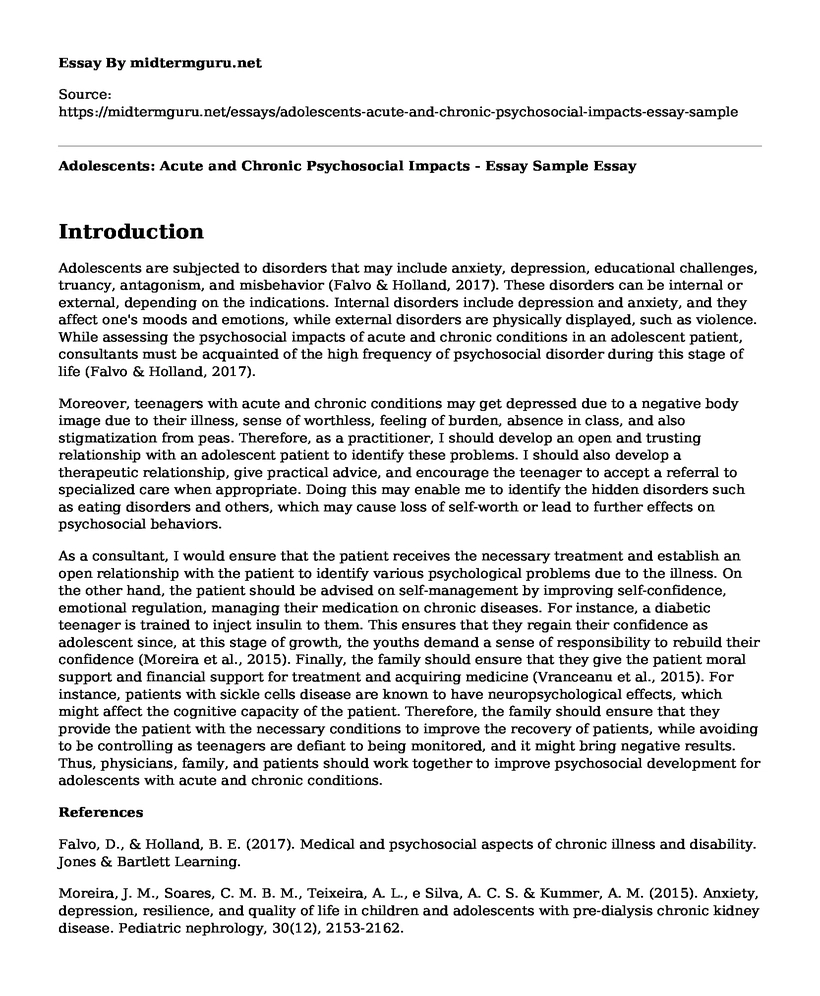Introduction
Adolescents are subjected to disorders that may include anxiety, depression, educational challenges, truancy, antagonism, and misbehavior (Falvo & Holland, 2017). These disorders can be internal or external, depending on the indications. Internal disorders include depression and anxiety, and they affect one's moods and emotions, while external disorders are physically displayed, such as violence. While assessing the psychosocial impacts of acute and chronic conditions in an adolescent patient, consultants must be acquainted of the high frequency of psychosocial disorder during this stage of life (Falvo & Holland, 2017).
Moreover, teenagers with acute and chronic conditions may get depressed due to a negative body image due to their illness, sense of worthless, feeling of burden, absence in class, and also stigmatization from peas. Therefore, as a practitioner, I should develop an open and trusting relationship with an adolescent patient to identify these problems. I should also develop a therapeutic relationship, give practical advice, and encourage the teenager to accept a referral to specialized care when appropriate. Doing this may enable me to identify the hidden disorders such as eating disorders and others, which may cause loss of self-worth or lead to further effects on psychosocial behaviors.
As a consultant, I would ensure that the patient receives the necessary treatment and establish an open relationship with the patient to identify various psychological problems due to the illness. On the other hand, the patient should be advised on self-management by improving self-confidence, emotional regulation, managing their medication on chronic diseases. For instance, a diabetic teenager is trained to inject insulin to them. This ensures that they regain their confidence as adolescent since, at this stage of growth, the youths demand a sense of responsibility to rebuild their confidence (Moreira et al., 2015). Finally, the family should ensure that they give the patient moral support and financial support for treatment and acquiring medicine (Vranceanu et al., 2015). For instance, patients with sickle cells disease are known to have neuropsychological effects, which might affect the cognitive capacity of the patient. Therefore, the family should ensure that they provide the patient with the necessary conditions to improve the recovery of patients, while avoiding to be controlling as teenagers are defiant to being monitored, and it might bring negative results. Thus, physicians, family, and patients should work together to improve psychosocial development for adolescents with acute and chronic conditions.
References
Falvo, D., & Holland, B. E. (2017). Medical and psychosocial aspects of chronic illness and disability. Jones & Bartlett Learning.
Moreira, J. M., Soares, C. M. B. M., Teixeira, A. L., e Silva, A. C. S. & Kummer, A. M. (2015). Anxiety, depression, resilience, and quality of life in children and adolescents with pre-dialysis chronic kidney disease. Pediatric nephrology, 30(12), 2153-2162. https://link.springer.com/article/10.1007/s00467-015-3159-6
Vranceanu, A. M., Merker, V. L., Park, E. R., & Plotkin, S. R. (2015). Quality of life among children and adolescents with neurofibromatosis 1: a systematic review of the literature. Journal of neuro-oncology, 122(2), 219-228. https://link.springer.com/article/10.1007/s11060-015-1725-1
Cite this page
Adolescents: Acute and Chronic Psychosocial Impacts - Essay Sample. (2023, Feb 03). Retrieved from https://midtermguru.com/essays/adolescents-acute-and-chronic-psychosocial-impacts-essay-sample
If you are the original author of this essay and no longer wish to have it published on the midtermguru.com website, please click below to request its removal:
- Feelings of Rejection - Assignment Example
- Health Problems Affecting the Maori People Paper Example
- Paper Example on Institutional Discrimination and Affirmative Action
- Bullying: Case Study
- Essay Sample on Nurse Manager Leadership Strengths
- Sinusitis: Understanding the Inflammation of the Sinuses - Essay Sample
- Similarities in The Bear Came Over The Mountain and Away From Her - Essay Sample







